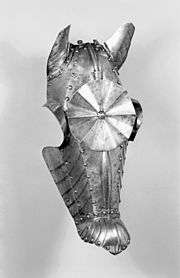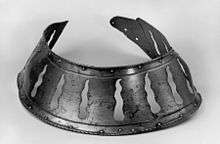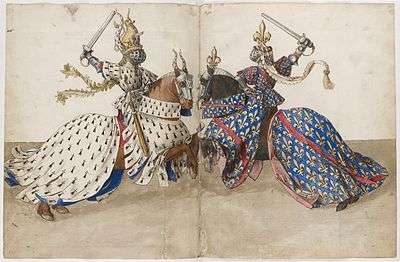Barding
Barding (also spelled bard or barb) is body armour for war horses. The practice of armoring horses was first extensively developed in antiquity in the eastern kingdoms of Parthia and Pahlava, and after the conquests of Alexander the Great it made its way into European military practices via the Seleucid Empire and later Byzantine Empire. Though its historical roots lie in antiquity in the regions of what was once the Persian Empire, barded horses have become a symbol of the late European Middle Ages chivalry and the era of knights.
During the Late Middle Ages as armour protection for knights became more effective, their mounts became targets. This vulnerability was exploited by the Scots at the Battle of Bannockburn in the 14th century, when horses were killed by the infantry, and for the English at the Battle of Crécy in the same century where longbowmen shot horses and the then dismounted French knights were killed by heavy infantry. Barding developed as a response to such events.
Examples of armour for horses could be found as far back as classical antiquity. Cataphracts, with scale armour for both rider and horse, are believed by many historians to have influenced the later European knights, via contact with the Byzantine Empire.[1]
Surviving period examples of barding are rare; however, complete sets are on display at the Philadelphia Museum of Art,[2] the Wallace Collection in London, the Royal Armouries in Leeds, and the Metropolitan Museum of Art in New York. Horse armour could be made in whole or in part of cuir bouilli (hardened leather), but surviving examples of this are especially rare.[3]
Chanfron

The chanfron (also spelled chaffron, champion, chamfron, chamfrein, champron, and shaffron) was designed to protect the horse's face. Sometimes this included hinged cheek plates. A decorative feature common to many chanfrons is a rondel with a small spike.[4]
The chanfron was known as early as ancient Greece, but vanished from use in Europe until the twelfth century when metal plates replaced boiled leather as protection for war horses. The basic design of the chanfron remained stable until it became obsolete in the seventeenth century, although late examples are often notable for engraved decoration. A chanfron extended from the horse's ears to its muzzle. Flanges often covered the eyes. In an open chanfron, the eyes received no protection. Hinged extensions to cover the jowls were commonly used for jousting tournaments.[5]
The enigmatic Torrs pony-cap from Scotland appears to be a bronze chanfron from about the 2nd century BC, perhaps later fitted with the bronze horns found with it.
Criniere
The criniere (also known as manefaire or crinet) was a set of segmented plates that protected the horse's neck.
In full barding this consisted of two combinations of articulated lames that pivoted on loose rivets. One set of lames covered the mane and the other covered the neck. These connected to the peytral and the chanfron.[6]
Light barding used only the upper lames. Three straps held the crinet in place around the neck.[6] It is thought that thin metal was used for these plates, perhaps 0.8 mm. Mail armour was often affixed to the crinet and wrapped about the horse's neck for additional protection.
Croupiere
The croupiere (also crupiere bacul or crupper) protected the horse's hind quarters. It could be made from any combination of leather, mail, or plate armour.
Flanchard

The flanchards, used to protect the flank, attached to the side of the saddle, then around the front or rear of the horse and back to the saddle again. These appear to have been metal plates riveted to leather or in some cases cuir bouilli armour (which is boiled or treated leather sealed with beeswax or the like).
They sometimes had openings designed to allow the rider to use spurs.
Peytral
The peytral was designed to protect the chest of the horse, while the croupiere protected the rear. It sometimes stretched as far back as the saddle.
Caparisons

Barding was often used in conjunction with cloth covers known as caparisons. These coverings sometimes covered the entire horse from nose to tail and extended to the ground. It is unclear from period illustrations how much metal defensive covering was used in conjunction. Textile covers may also be called barding.
Other features
Another commonly included feature of barding was protection for the reins, so they could not be cut. This could be metal plates riveted to them as seen in the images here, or chainmail linked around them.
Notes
- Nell, Grant S. (1995) The Savaran: The Original Knights. University of Oklahoma Press.
- Horse Armor of Duke Ulrich of Württemberg at the Philadelphia Museum of Art
- Phyrr et al., 57-59
- Broughton, p. 100
- Mondadore, pp. 417 - 418.
- Mondadore, p. 143.
References
- Broughton, Branford B. Dictionary of Medieval Knighthood and Chivalry: Concepts and Terms, (Westport, Connecticut: Greenwood Press, 1986).
- Mondadore, Arnoldo, ed. The Complete Encyclopedia of Arms & Weapons, (New York:Simon & Schuster, 1979).
- Pyhrr, Stuart W.; LaRocca, Donald J.; Breiding, Dirk H. (2005). The Armored Horse in Europe, 1480–1620. New York: Metropolitan Museum of Art. ISBN 9781588391506.
- Stone, George Cameron (1934). A Glossary of the Construction, Decoration, and Use of Arms and Armor in All Countries and in All Times, Mineola: Dover Publications. ISBN 0-486-40726-8
External links
| Look up barding in Wiktionary, the free dictionary. |
- Overview of Bards images of barding from period documents